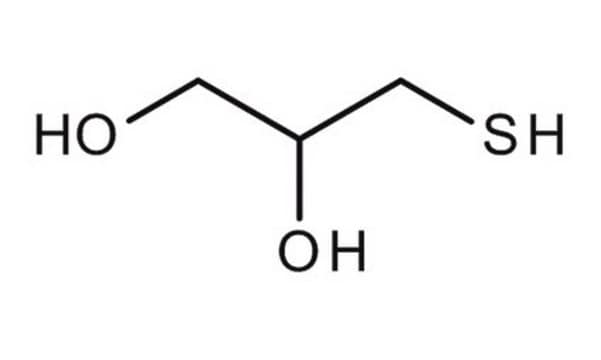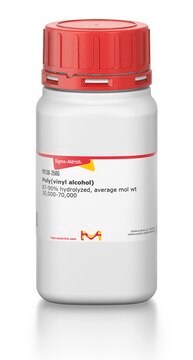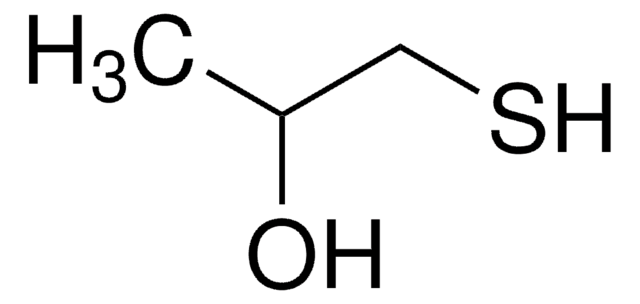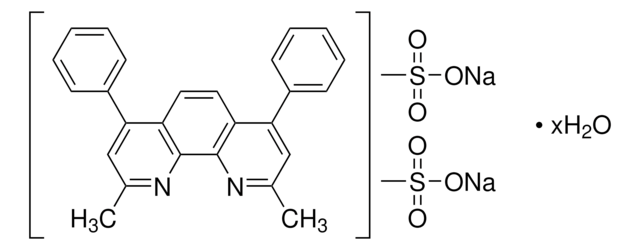To avoid contamination, sterile filtration is highly recommended prior to cell culture application. Upon verification, the lab has not formulated a protocol for cell culture use. However, the following citation on M1753 for cell culture application may be of interest as a protocol reference: Im, H. (2011). "Mouse Embryonic Stem Cell Maintenance for Differentiation." Bio-101: e145. DOI: 10.21769/BioProtoc.145.
M1753
1-tioglicerolo
≥97%
Sinonimo/i:
αα-monotioglicerolo, αα-tioglicerolo, 3-mercapto-1,2-propanediolo
Scegli un formato
Scegli un formato
About This Item
Prodotti consigliati
Saggio
≥97%
Stato
liquid
Indice di rifrazione
n20/D 1.527 (lit.)
P. ebollizione
118 °C/5 mmHg (lit.)
Densità
1.25 g/mL at 25 °C (lit.)
Temperatura di conservazione
2-8°C
Stringa SMILE
OCC(O)CS
InChI
1S/C3H8O2S/c4-1-3(5)2-6/h3-6H,1-2H2
PJUIMOJAAPLTRJ-UHFFFAOYSA-N
Cerchi prodotti simili? Visita Guida al confronto tra prodotti
Descrizione generale
Applicazioni
Nota sulla preparazione
Avvertenze
Danger
Indicazioni di pericolo
Consigli di prudenza
Classi di pericolo
Acute Tox. 3 Dermal - Acute Tox. 3 Inhalation - Acute Tox. 4 Oral - Skin Irrit. 2 - Skin Sens. 1B
Codice della classe di stoccaggio
6.1C - Combustible acute toxic Cat.3 / toxic compounds or compounds which causing chronic effects
Classe di pericolosità dell'acqua (WGK)
WGK 3
Punto d’infiammabilità (°F)
210.2 °F - closed cup
Punto d’infiammabilità (°C)
99 °C - closed cup
Dispositivi di protezione individuale
Eyeshields, Faceshields, Gloves, type ABEK (EN14387) respirator filter
Scegli una delle versioni più recenti:
Possiedi già questo prodotto?
I documenti relativi ai prodotti acquistati recentemente sono disponibili nell’Archivio dei documenti.
I clienti hanno visto anche
-
What could be causing contamination of cell culture experiments while using M1753? Also, how should M1753 be added to the cell culture media?
1 risposta-
Utile?
-
-
What is the Department of Transportation shipping information for this product?
1 risposta-
Transportation information can be found in Section 14 of the product's (M)SDS.To access the shipping information for this material, use the link on the product detail page for the product.
Utile?
-
-
How does the storage temperature relate to shipping conditions?
1 risposta-
The storage conditions that a Sigma-Aldrich catalog and label recommend for products are deliberately conservative. For many products, long-term storage at low temperatures will increase the time during which they are expected to remain in specification and therefore are labeled accordingly. Where short-term storage, shipping time frame, or exposure to conditions other than those recommended for long-term storage will not affect product quality, Sigma-Aldrich will ship at ambient temperature. The products sensitive to short-term exposure to conditions other than their recommended long-term storage are shipped on wet or dry ice. Ambient temperature shipping helps to control shipping costs for our customers. At any time, our customers can request wet- or dry-ice shipment, but the special handling is at customer expense if our product history indicates that the product is stable for regular shipment.
Utile?
-
-
What is the concentration of the 1-thioglycerol?
1 risposta-
The liquid is not a solution of 1-thioglycerol in some solvent. Rather, it is a neat liquid (i.e., essentially pure 1-thioglycerol). Based on a density of 1.245 g/mL and a molecular weight of 108.2 g/mole, one can calculate an effective molarity of 11.5 M. This information may be found on the M1753 product information sheet.
Utile?
-
Filtri attivi
Il team dei nostri ricercatori vanta grande esperienza in tutte le aree della ricerca quali Life Science, scienza dei materiali, sintesi chimica, cromatografia, discipline analitiche, ecc..
Contatta l'Assistenza Tecnica.









